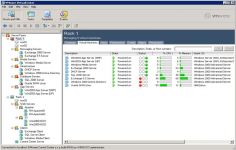 VMware Server 1.0.7
VMware Server 1.0.7
VMware Inc - (Freeware)
VMware Server allows server virtualization by sharing a physical server into multiple virtual machines.
VMware Server is a software based on server virtualization technology for Windows and Linux servers with enterprise-class support. It allows companies to share a physical server into multiple virtual machines.
VMware Server supports Linux and Windows servers for x86 hardware and 64-bit operating systems (Windows, Linux and Solaris), used by single or multi-core processors. This software is also compatible with Intel virtualization technology.
VMware Server is installed as an application and it allows the creation of virtual machines, through an assistant, VMware or Microsoft formats. It increase the CPU utilization of a physical server and it is able to move virtual machines from one physical server to another without re-configuration.
The software can be very easily used even by the inexperienced users.
- Title:
- VMware Server 1.0.7
- File Size:
- 147.0 MB
- Requirements:
- Windows 2000 / XP / Vista / Windows7 / XP64 / Vista64 / Windows7 64 / Windows8 / Windows8 64
- Language:
- en-us
- License:
- Freeware
- Date Added:
- 28 Aug 2008
- Publisher:
- VMware Inc
- Homepage:
- http://www.vmware.com
- MD5 Checksum:
- 2E2EE5EBE08AE48EAC5E661CAD01ACF6
Server 1.0.7 addresses the following security issues:
* Security Fix for VMware ISAPI Extension
Internet Server Application Programming Interface (ISAPI) is an API that extends the functionality of Internet Information Server (IIS). VMware uses ISAPI extensions in its Server product.
One of the ISAPI extensions provided by VMware is vulnerable to a remote denial of service. By sending a malformed request, IIS might shut down. IIS 6.0 restarts automatically. However, IIS 5.0 does not restart automatically when its Startup Type is set to Manual.
The Common Vulnerabilities and Exposures has assigned the name CVE-2008-3697 to this issue.
* Setting ActiveX killbit
From this release, VMware has set the killbit on its ActiveX controls. Setting the killbit ensures that ActiveX controls cannot run in Internet Explorer (IE), and avoids security issues involving ActiveX controls in IE. See the KB article 240797 from Microsoft and the related references on this topic.
Security vulnerabilities have been reported for ActiveX controls provided by VMware when run in IE. Under specific circumstances, exploitation of these ActiveX controls might result in denial-of-service or can allow running of arbitrary code when the user browses a malicious Web site or opens a malicious file in IE browser. An attempt to run unsafe ActiveX controls in IE might result in pop-up windows warning the user.
Note: IE can be configured to run unsafe ActiveX controls without prompting. VMware recommends that you retain the default settings in IE, which prompts when unsafe actions are requested.
Earlier, VMware had issued knowledge base articles, KB 5965318 and KB 9078920 on security issues with ActiveX controls.
To avoid malicious scripts that exploit ActiveX controls, do not enable unsafe ActiveX objects in your browser settings. As a best practice, do not browse untrusted Web sites as an administrator and do not click OK or Yes if prompted by IE to allow certain actions.
The Common Vulnerabilities and Exposures has assigned the names CVE-2008-3691, CVE-2008-3692, CVE-2008-3693, CVE-2008-3695, CVE-2007-5438, and CVE-2008-3696 to the security issues with VMware ActiveX controls.
* Security Fix for Local Privilege Escalation on Host System
This release fixes a privilege escalation vulnerability in host operating systems. Exploitation of this vulnerability allows users to run arbitrary code on the host system with elevated privileges.
The Common Vulnerabilities and Exposures has assigned the name CVE-2008-3698 to this issue.
* Update to Freetype
FreeType 2.3.6 resolves an integer overflow vulnerability and other vulnerabilities that can allow malicious users to run arbitrary code or might cause a denial-of-service after reading a maliciously crafted file. This release updates FreeType to its latest version 2.3.7.
The Common Vulnerabilities and Exposures has assigned the names CVE-2008-1806, CVE-2008-1807, and CVE-2008-1808 to the issues resolved in Freetype 2.3.6.
Related software
2.1/5 from 176 users
